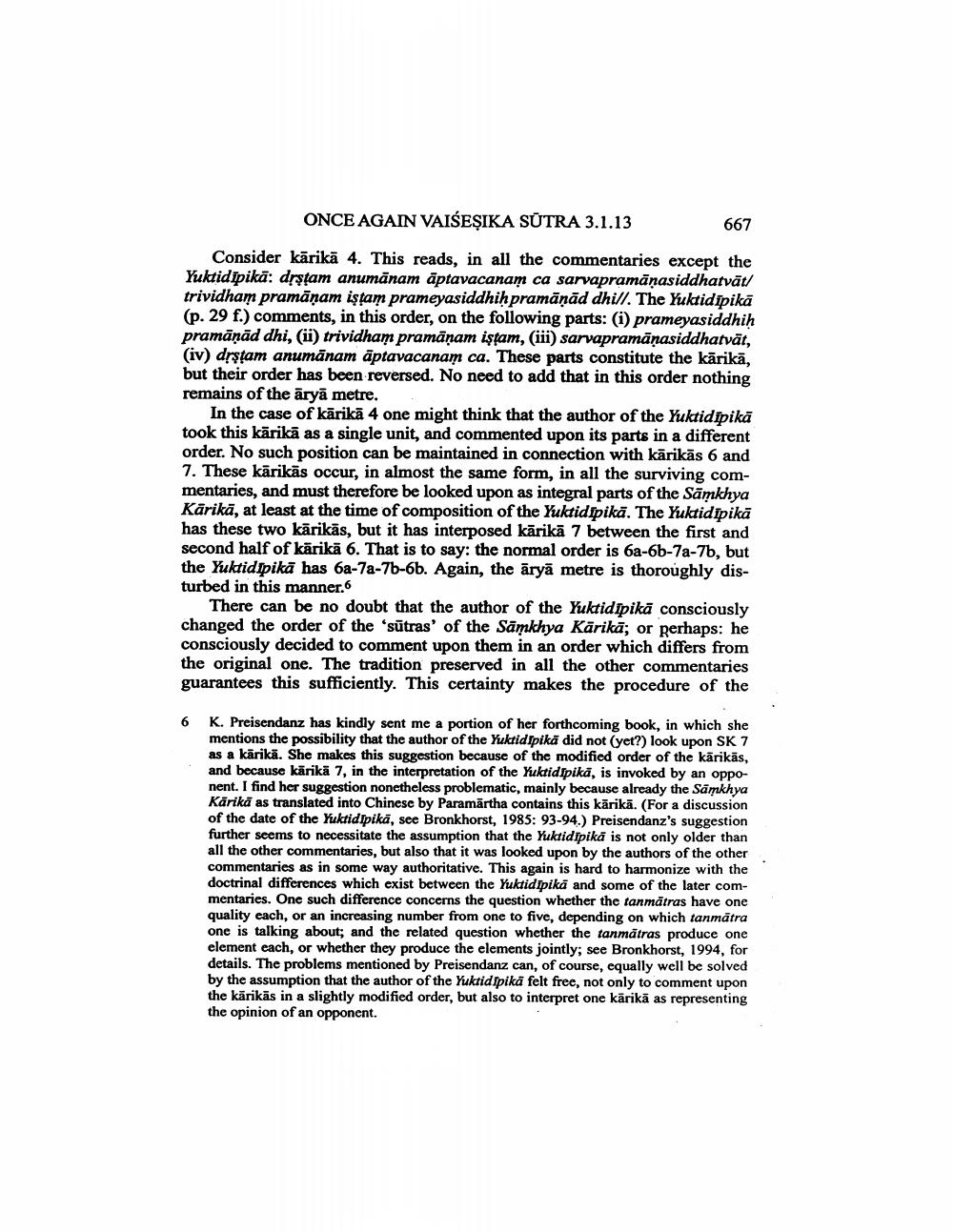________________
ONCE AGAIN VAIŠEŞIKA SŪTRA 3.1.13
667
Consider kārikā 4. This reads, in all the commentaries except the Yuktidipikā: drstam anumānam aptavacanam ca sarvapramāṇasiddhatvāt/ trividham pramāņam istam prameyasiddhih pramāņād dhill. The Yuktidipika (p. 29 f.) comments, in this order, on the following parts: (i) prameyasiddhih pramāņād dhi, (ii) trividham pramānam iştam, (iii) sarvapramānasiddhatvāt, (iv) dystam anumānam āptavacanam ca. These parts constitute the kārikā, but their order has been reversed. No need to add that in this order nothing remains of the āryā metre. .
In the case of kārikā 4 one might think that the author of the Yuktidipikā took this kārikā as a single unit, and commented upon its parts in a different order. No such position can be maintained in connection with kārikās 6 and 7. These kārikās occur, in almost the same form, in all the surviving commentaries, and must therefore be looked upon as integral parts of the Samkhya Karikā, at least at the time of composition of the Yuktidipikā. The Yuktidipikā has these two kārikās, but it has interposed kārikā 7 between the first and second half of kārikā 6. That is to say: the normal order is 6a-6b-7a-7b, but the Yuktid pikā has 6a-7a-7b-6b. Again, the āryā metre is thoroughly disturbed in this manner.6
There can be no doubt that the author of the Yuktidipikā consciously changed the order of the 'sūtras' of the Samkhya Kärikā; or perhaps: he consciously decided to comment upon them in an order which differs from the original one. The tradition preserved in all the other commentaries guarantees this sufficiently. This certainty makes the procedure of the
6
K. Preisendanz has kindly sent me a portion of her forthcoming book, in which she mentions the possibility that the author of the Yuktid Ipikā did not (yet?) look upon SK 7 as a karikā. She makes this suggestion because of the modified order of the kārikās, and because kärikä 7, in the interpretation of the Yuktid Ipika, is invoked by an opponent. I find her suggestion nonetheless problematic, mainly because already the Samkhya Karika as translated into Chinese by Paramārtha contains this kārikā. (For a discussion of the date of the Yuktidspikā, see Bronkhorst, 1985: 93-94.) Preisendanz's suggestion further seems to necessitate the assumption that the Yuktidipika is not only older than all the other commentaries, but also that it was looked upon by the authors of the other commentaries as in some way authoritative. This again is hard to harmonize with the doctrinal differences which exist between the Yuktidipika and some of the later commentaries. One such difference concerns the question whether the tanmātras have one quality each, or an increasing number from one to five, depending on which tanmatra one is talking about; and the related question whether the tanmatras produce one element each, or whether they produce the elements jointly; see Bronkhorst, 1994, for details. The problems mentioned by Preisendanz can, of course, equally well be solved by the assumption that the author of the Yuktidipika felt free, not only to comment upon the kārikās in a slightly modified order, but also to interpret one kārikā as representing the opinion of an opponent.




